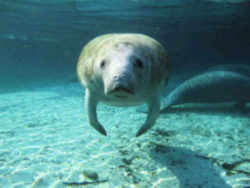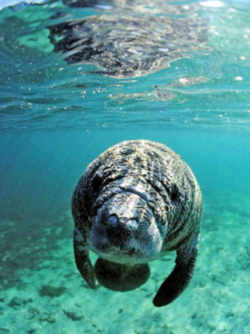Alabama Symbols
Alabama State Marine Mammal
West Indian Manatee

(Trichechus manatus)
Adopted on May 13, 2009
The West Indian Manatee, (Trichechus manatus,) also called a sea cow, is a gray, waterplant-eating, gentle giant that reaches eight to fourteen feet in length and can weigh more than a ton. It was designated the Alabama state marine mammal on May 13, 2009.
Alabama State Marine Mammal: West Indian Manatee

A rare visitor to the Alabama coast, the West Indian manatee is a large in-shore marine mammal that typically grows to 9 or 10 feet in length and can weigh 1000 pounds or more. They prefer warmer waters, and their habitat is limited to the Caribbean, Florida and southern Georgia, though they have been sighted as far north as the Carolinas, and as far west as Texas. Manatees are herbivores, meaning they feed on the aquatic vegetation found mostly in shallow waters. Because this is also the favored habitat of many boaters, manatees are in danger from encounters with boat propellers.
Manatees are protected under the Marine Mammal Protection Act, which prohibits the take (i.e., harass, hunt, capture, or kill) of all marine mammals. Manatees are found in marine, estuarine, and freshwater environments. The West Indian manatee, Trichechus manatus, includes two distinct subspecies, the Florida manatee (Trichechus manatus latirostris) and the Antillean manatee (Trichechus manatus manatus). While morphologically distinctive, both subspecies have many common features. Manatees have large, seal-shaped bodies with paired flippers and a round, paddle-shaped tail.
Whatever the name - Sea Cow, Big Beaver, Mermaid or "Furnished with Hands"- the main place the hulking manatee is found in the United
States is Alabama. The State Marine Mammal are typically grey in color (color can range from black to light brown) and occasionally spotted with barnacles
or colored by patches of green or red algae. The muzzle is heavily whiskered and coarse, single hairs are sparsely distributed throughout the body.
Adult manatees, on average, are about nine feet long (3 meters) and weigh about 1,000 pounds (200 kilograms). At birth, calves are between three and
four feet long (1 meter) and weigh between 40 and 60 pounds (30 kilograms).
Manatee may have developed from the Hatian word "manati," which means "big beaver." Although appropriate in its description of this docile, slow-moving
mammal, the more likely derivation of the name comes from the Latin "manatus" - meaning "furnished with hands." The manatee's flippers can appear almost
hand-like from a distance. That observation plus the presence of a tail perhaps fostered the legend that manatees were "mermaids." Coincidentally,
the order to which the manatee belongs is called Sirenia - meaning siren or mermaid. The manatee is on the endangered species list, but chances for
its survival are good if man's activities can be controlled. Of all the known causes of manatee mortality, man is responsible for about half of the
deaths. The single greatest-known cause of mortality is boats and barges. To a manatee, a speeding boat is more hazardous than disease, weather, poachers,
or alligators, for its propeller blades can cut a manatee's thick hide to ribbons.
Alabama Code
The law designating the West Indian Manatee as the official Alabama state marine mammal is found in The Code of Alabama 1975, Title 1, Chapter 2.
Title 1 GENERAL PROVISIONS.
Chapter 2 STATE SYMBOLS AND HONORS.
Section 1-2-38 State marine mammal.
Section 1-2-38
State marine mammal.
The West Indian Manatee, family Trichechidae, order Sirenia, species Trichechus manatus, is hereby designated as the official state marine mammal of
Alabama.
(Act 2009-488, p. 891,§1.)
Taxonomic Hierarchy: West Indian Manatee
Kingdom: Animalia
Phylum: Chordata
Class: Mammalia
Order: Sirenia
Family: Trichechidae
Genus: Trichechus
Species: T. manatus








